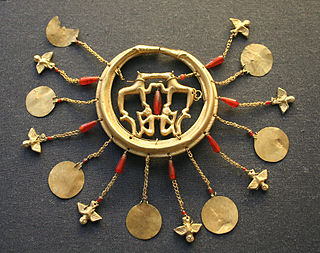 W
WThe Aegina Treasure or Aigina Treasure is an important Minoan gold hoard found on the island of Aegina, Greece. Since 1892, it has been part of the British Museum's collection.
 W
WThe Arcisate Treasure is a Roman silver hoard found in the town of Arcisate, northern Italy. Soon after its discovery in 1900, the treasure was acquired by the British Museum According to scholars, the treasure's significance is due to the completeness of the set, the high quality of the craftsmanship and materials used to make it, as well as the hoard's excellent state of preservation.
 W
WThe Barber Cup and Crawford Cup are two non-matching carved fluorite cups from about 50–100 AD. They were discovered during World War I by an Austro-Croatian officer who excavated a Roman tomb near the current Turkish–Syrian border. Both cups are now in the collection of the British Museum, which acquired the Crawford Cup in 1971 and the Barber Cup in 2004. The two cups are the only two vessels carved from fluorite that are known to have survived intact from the Roman period.
 W
WThe Beaurains Treasure is the name of an important Roman hoard found in Beaurains, a suburb of the city of Arras, northern France in 1922. Soon after its discovery, much of the treasure was dispersed, to be sold on the antiquities market. However, the largest portion of the hoard can be found in the local museum in Arras and in the British Museum.
 W
WThe Blacas Cameo is an unusually large Ancient Roman cameo, 12.8 cm (5.0 in) high, carved from a piece of sardonyx with four alternating layers of white and brown. It shows the profile head of the Roman emperor Augustus and probably dates from shortly after his death in AD 14, perhaps from AD 20-50. It has been in the British Museum since 1867, when the museum acquired the famous collection of antiquities that Louis, Duke of Blacas had inherited from his father, also including the Esquiline Treasure. Normally it is on display in Room 70.
 W
WThe Boscoreale Treasure is the name for a large collection of exquisite silver and gold Roman objects discovered in the ruins of the ancient Villa della Pisanella at Boscoreale, near Pompeii, southern Italy. Consisting of over a hundred pieces of silverware, as well as gold coins and jewellery, it is now mostly kept at the Louvre Museum in Paris, although parts of the treasure can also be found at the British Museum.
 W
WThe Braganza Brooch is a gold ornamental fibula that was made in the third century BC by a Greek craftsman for a Celtic Iberian client. Since its discovery in unknown circumstances in the nineteenth century in Portugal, it has belonged to a variety of owners, including various members of the House of Braganza, for which it is named, before being purchased by the British Museum in 2001..
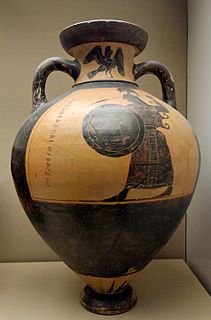 W
WThe Burgon vase is the earliest known Panathenaic prize amphora, dating to around 560 BC, and the name vase for the ancient Greek painter of the Burgon Group. Today it is on display in the British Museum. The 61 cm high vase is short and squat, with a very low mouth and short neck. The handles are close to the body and small. The foot is tiny in proportion to the vase. The amphora was uncovered in 1813 in Athens and is named after Thomas Burgon (1787–1858), a merchant of the Levant Company, who brought it to England and sold it to the museum. It was discovered full of bone fragments, having been used as a funerary urn. The back side of the vase was seriously damaged by a pick-axe during the excavation.
 W
WThe Bursa Treasure or Brusa Treasure is the name of an early Roman silver hoard found in the city of Bursa, Turkey. Since 1913, the entire treasure has been at the British Museum.
 W
WThe Carthage Treasure is a Roman silver hoard, which was found in Tunis, Tunisia, at the site of the ancient city of Carthage. The treasure principally consists of silver tableware and jewellery, most of which is now held at the British Museum.
 W
WThe Caubiac Treasure is a Roman silver hoard found in the village of Thil, southern France in 1785 that is now kept in the British Museum in London.
 W
WThe Chaourse Treasure is a hoard of Roman silver found in Chaourse, a village near Montcornet, Aisne in northern France in 1883. Dating between the 2nd and 3rd centuries AD, the treasure is one of the most complete table services to survive from antiquity. This important hoard is now part of the British Museum's collection.
 W
WThe Chatuzange Treasure is the name of an important Roman silver hoard found in the village of Chatuzange-le-Goubet in the department of Drôme, south-eastern France. Since 1893 it has been part of the British Museum's collection.
 W
WThe Elgin Amphora is a large Ancient Greek neck-handled amphora made from fired clay in Athens around 760 to 750 BC. The ceramic vessel may have been used to hold wine at a funeral feast, and then entombed with the cremated remains of the deceased. Fragments have survived, decorated in the Late Geometric style, and attributed to an unknown artist given the Notname of "the Dipylon Master", one of the earliest individually identifiable Greek artists. The fragments have been restored to reconstruct a single but incomplete vessel, 67 centimetres (26 in) high, which is now displayed at the British Museum in London.
 W
WThe Esquiline Treasure is an ancient Roman silver treasure that was found in 1793 on the Esquiline Hill in Rome. The hoard is considered an important example of late antique silver work from the 4th century AD, probably about 380 for the major pieces. Since 1866, 57 objects, representing the great majority of the treasure, have been in the British Museum.
 W
WThe Euphorbos plate is the name of an East Greek plate with mythological painting in the Orientalising style.
 W
WThe Isis Tomb is the name of a richly endowed Etruscan tomb that was found at the Polledrara Cemetery, Vulci, Lazio, Italy, in the early nineteenth century. Many artefacts were discovered in the Isis Tomb when it was originally excavated but, as was custom at the time, only objects of high monetary value were kept. Over 60 of these objects are now held by the British Museum, with others scattered across a range of museums around the world.
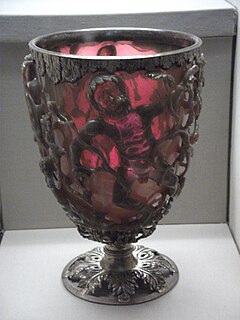 W
WThe Lycurgus Cup is a 4th-century Roman glass cage cup made of a dichroic glass, which shows a different colour depending on whether or not light is passing through it: red when lit from behind and green when lit from in front. It is the only complete Roman glass object made from this type of glass, and the one exhibiting the most impressive change in colour; it has been described as "the most spectacular glass of the period, fittingly decorated, which we know to have existed".
 W
WThe Macmillan aryballos is a Protocorinthian pottery aryballos in the collection of the British Museum. Dating to about 640 BC, it is 6.9 cm high and 3.9 cm in diameter, and weighs 65 grams.
 W
WThe Mâcon Treasure or Macon Treasure is the name of a Roman silver hoard found in the city of Mâcon, eastern France in 1764. Soon after its discovery, the bulk of the treasure disappeared, with only 8 silver statuettes and a silver plate identified as being part of the original find. All of these objects are now in the British Museum
 W
WThe Mainz Gladius or Sword of Tiberius is a famous ancient Roman sword and sheath that was found in the Rhine near Mainz in Germany. Since 1866 it has been part of the British Museum's collection, when it was given to the museum by the philanthropist Felix Slade. A replica of the Mainz Gladius can be found in the Romano-Germanic Central Museum (Mainz). The type of gladius was first introduced to the Romans in 20 BC. Eventually the Mainz Gladius was overtaken in popularity by the Pompeii Gladius.
 W
WThe Oscan Tablet or Agnone Tablet is a bronze inscription written in the Oscan alphabet that dates to the 3rd century BC. It was found near the town of Agnone in Molise, Italy. Since 1873, the original has been kept in the British Museum. It is, along with the Tabula Bantina and the Abellano Boundary Stone from Avella, one of the most important inscriptions extant in the long extinct Oscan language.
 W
WThe Paramythia Hoard or Paramythia Treasure is the name of a Greco-Roman hoard of bronze figurines and other objects found in Paramythia, north-west Greece in the late 18th century. Of the original nineteen objects found in the hoard, fourteen are now in the British Museum
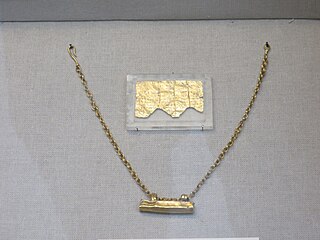 W
WThe Petelia Gold Tablet or Petelia Tablet is an orphic inscription or Totenpass that was found near the ancient city of Petelia, southern Italy in the early nineteenth century. Since 1843, the original has been kept in the British Museum.
 W
WThe Portland Vase is a Roman cameo glass vase, which is dated to between AD 1 and AD 25, though low BC dates have some scholarly support. It is the best known piece of Roman cameo glass and has served as an inspiration to many glass and porcelain makers from about the beginning of the 18th century onwards. It is first recorded in Rome in 1600–1601, and since 1810 has been in the British Museum in London. It was bought by the museum in 1945 and is normally on display in Room 70.
 W
WThe Priene Inscription is a dedicatory inscription by Alexander the Great that was discovered at the Temple of Athena Polias, in the city of Priene in Asia Minor in the nineteenth century. It now forms an important part of the British Museum's Ancient Greek epigraphic collection and provides a direct link to one of the most famous persons in ancient history. This inscription about the dedication of a temple by Alexander to Athena Polias, which has been held at the British Museum in London, should not be confused with the Calendar Inscription of Priene also found at Priene in Turkey, which is about Augustus Caesar, and about redefining the calendar around the birthdate of Augustus Caesar.
 W
WThe San Sosti Axe-Head is an ancient bronze head of an axe that was originally found near the town of San Sosti, province of Cosenza in Calabria, southern Italy. Based on its Ancient Greek inscription, it is now considered to be an elaborately crafted votive offering to the gods.
 W
WThe Sant'Angelo Muxaro Patera is an ancient gold libation bowl that was discovered as part of a larger hoard in the seventeenth century near the hilltop town of Sant'Angelo Muxaro in Sicily, southern Italy. Since 1772, this rare and precious find has been part of the British Museum's Ancient Greek collection.
 W
WSatala Aphrodite is the name given to the larger than life-size head of an ancient Hellenistic statue discovered in Satala. It was acquired by the British Museum in 1873 and is on display in the museum's Department of Greek and Roman Antiquities. Whether it depicts Greek Aphrodite or her Armenian equivalent Anahit is debated. It is usually dated around the 2nd–1st centuries BC.
 W
WThe Uerdingen Hoard or Uerdingen Treasure is the name of an historically significant group of ancient objects found in a Roman grave in the town of Uerdingen, western Germany. Discovered in the middle of the nineteenth century, the entire hoard was donated to the British Museum in 1868.
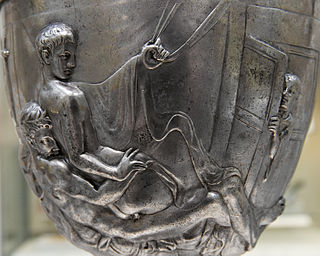 W
WThe Warren Cup is an ancient Greco-Roman silver drinking cup decorated in relief with two images of male same-sex acts. It was purchased by the British Museum for £1.8 million in 1999, the most expensive single purchase by the museum at that time. It is usually dated to the time of the Julio-Claudian dynasty.
 W
WThe Xanten Horse-Phalerae is the name of a set of Roman silvered bronze horse-trappings found in Xanten, Germany. The set is now in the British Museum's Greek and Roman antiquities collection.